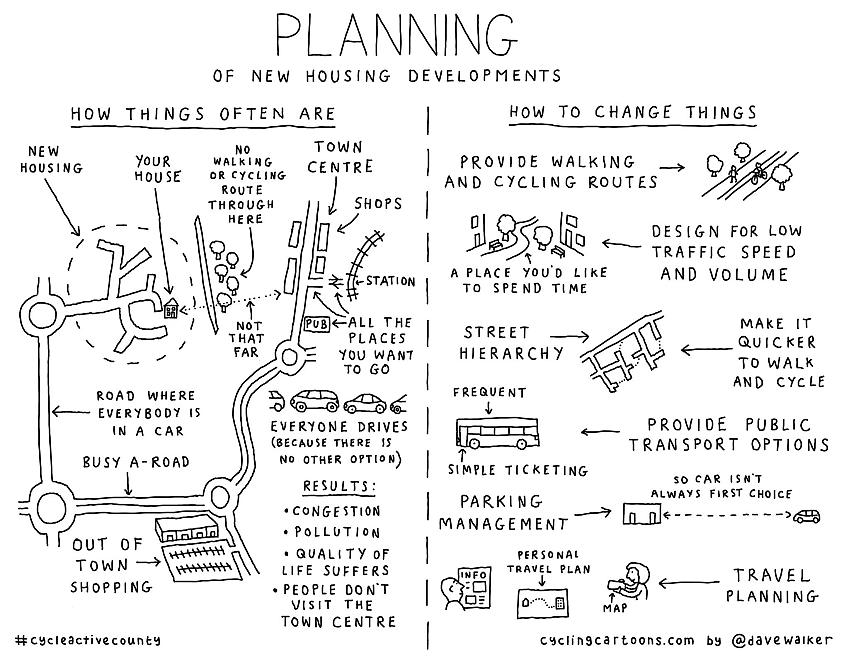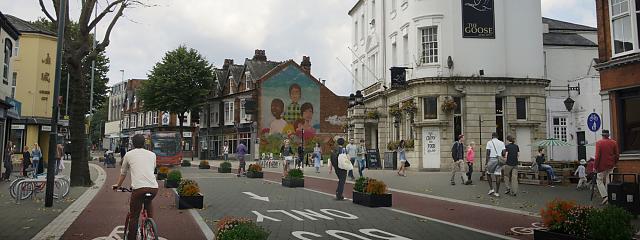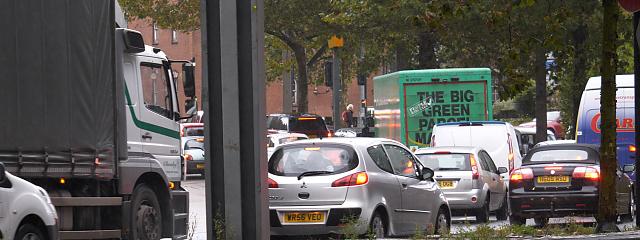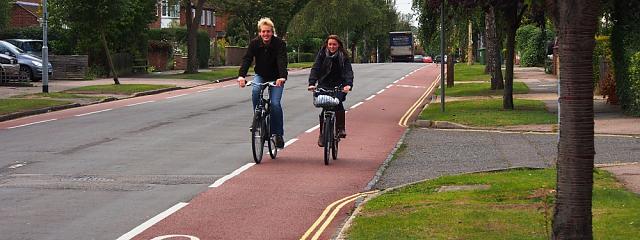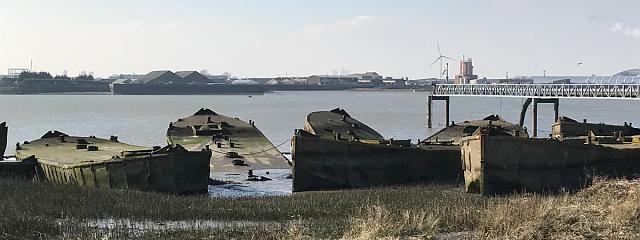
Can active travel and new housing live together happily ever after?
Can active travel and new housing live together happily ever after?
Some extremely organised and possibly rather irritating person once said, "if we fail to plan, we plan to fail."
So true. Who wants to end up with no sprouts in the house on Christmas Day? (If you’re saying ‘Yuk, yes I do!’, feel free to substitute a festive vegetable more to your liking).
Regardless of our propensity to succeed or fail on the sprout front, planning our everyday lives is at least a fairly easy concept to grasp.
But what about moving up the scale and getting our heads round ‘transport planning’? Not the sort of planning that happens in our kitchens when we’re choosing whether to walk, cycle or drive to the shops, but the sort of planning that professionals and politicians do round boardroom tables; the sort of planning that affects the built environment outdoors and, in turn, influences our personal decisions on how best to journey through it to get to wherever we need to go.
Today (20 November) is Transport Planning Day, a good day to muse on the impact that this particular beast – and it is a beast – has on almost every one of us.
Firstly, I think we need a professional definition of ‘transport planning’. The Transport Planning Society (TPS) says that it is “… all about creating connections between people and places, without which everyday life cannot function.”
That’s so beautifully put. So simple. But, as the Society stresses, it’s not a simple thing to do at all, partly because “Transport is almost entirely generated by where people and places are located.” Again, a very simple statement; self-evident, even. Where’s the complication for active travel, then?
Well, guess what’s most likely to happen if a council votes in favour of a new housing estate miles away from the nearest town and railway station, allows for no high street, few services and amenities, and invites developers to go wild with garage and car parking space?
What if its transport planners cater for all the extra traffic by constructing major roads and plonking nasty junctions at every exit? What if they’re remiss about footpaths, cycle-friendly routes and cut-throughs, and decide that buses need only call every other Friday?
The built environment will be saying “drive, it’s your only choice; your everyday life can’t function if you don’t”, that’s what will happen.
It’ll be saying don’t cycle to the shops; don’t walk to the bus stop – you’ll be lucky to find one anyway; don’t meet your recommended physical activity guidelines; forget any ideas about passing on a clean and liveable planet to future generations.
Cartoon: courtesy of Dave Walker
The alarming thing is that this seems to be exactly what some transport planners want new settlements to say. They’ve planned for car traffic, but seriously failed walking and cycling.
Equally alarming is the fact that all too often their colleagues across the way in departments dealing with how, where and why land is put to use, and developers themselves, don’t, won’t or can’t raise an eyebrow. Either that, or their eyebrows, if they’ve been brave enough to raise them, have got them nowhere against the transport planning might or, indeed, national and local planning policies and frameworks that shape all decisions on development.
This is yet more alarming when you consider the huge pressure on local authorities to meet their current housing targets, and the fact that you don’t have to go far to find a local community fearing for their quality of life because a development project nearby will generate so much more motorised traffic.
Indeed, Cycling UK’s own research, to be published soon (with case studies), proves that the alarming catalogue above is the norm rather than the exception.
Planning is a beast, as I say. But is it incorrigible? No. Although we may not see it as often as we’d like, it does have a sunny side and Transport Planning Day is all about winkling it out and capitalising on it.
The TPS has thus partnered with Transport for New Homes (TfNH) on an award for recent housing developments that “buck the trend for out-of-town car-dominated estates, places where real attention has been paid to sustainable transport and quality of life.”
The way we combine new homes with transport will determine how we travel and therefore the way we live for decades to come. Cutting back on car use and instead being able to walk, cycle or use public transport on a daily basis is all part of the lower carbon and healthier lifestyle that many people aspire to.
Jenny Raggett, Transport for New Homes.
The shortlist, nominated by professionals, housing developers and the public, boasts five new developments of over 500 homes, and here I’ve picked out a few prizewinning aspects of each that TfNH has highlighted and which resonate especially with Cycling UK:
Bath Riverside (Crest Nicholson / 2000+ homes planned) WINNER of non-metropolitan category
- It’s built in the centre of Bath, on the site of a disused gasworks – not miles out of town
- Every household receives a £100 cycle voucher
- The public realm is shaped around walking
- Its density will support local facilities
- Car parking is limited.
Kidbrooke Village, Greenwich (Berkeley Group / 4,800 houses when complete; 1,300 already constructed)
- Cycling and walking routes are direct, and surface-level crossings have replaced pedestrian subways
- There’s an on-site rail station, and even a temporary village centre with shops and services as a stopgap until permanent facilities are built
- Residents aren’t automatically expected to use a car as their main form of transport, and not all flats have car parking spaces
- The density is high.
Kilnwood Vale Phase 1 and 2, Crawley (Crest Nicholson / 2,500 dwellings when complete)
- A major urban extension that said ‘bus’ from the start. Services were assured from the early stages and a high quality shelter and Real-time Passenger Information are there for all prospective purchasers to see at the site entrance. (Giving a high profile to selected modes of travel from the start can be applied equally well to cycling).
Poundbury, Dorset (currently housing 3,800 people)
- Built according to the principles of Charles, Prince of Wales, on land owned by the Duchy of Cornwall, this urban extension to Dorchester accommodates both residential and commercial building
- With its offices, shops, pubs, cafes, communal areas and even a cereal factory, it employs 2,300+ people and sees over a quarter of its commuting residents walking to work
- Car parking is kept off the streets in courts to the rear of houses, and bus and train services are nearby.
Royal Arsenal Riverside, Woolwich (Berkeley Homes / 3,200 homes currently; 5,000 when complete) WINNER of metropolitan category
- All homes have secure cycle parking and there’s a riverfront cycle route into central London
- Car parking is hidden away in basements and, bar a few exemptions, there is no on-street parking
- The centre is pedestrianised, and walking is designed to be a peaceful, comfortable experience with green spaces and benches
- The site will be serviced by a new Crossrail station, and residents have a choice of buses and even a boat service into the city
- Amenities, such as cafes, pubs, food shops and leisure facilities are abundant, while light industrial units to the east are designed to accommodate larger employers and local start-ups.
It is unlikely, of course, that all of these sites enjoy unqualified critical acclaim, either from those who support their approach or from those who do not - Poundbury, which first arrived on Dorchester’s scene in 1993, is a case in point here. Also, it’s one thing to read about a development’s ethos and aspirations, and another to experience what it’s like to live there.
That said, between them these sites all exhibit principles that Cycling UK wants to see in all new housing developments all over the UK, eg:
- Locations chosen because they’re in or near existing settlements
- High density housing (a predominant principle of planning in the Netherlands, reducing urban sprawl, keeping average trip lengths as short as possible and making active travel the logical choice)
- On-site amenities and workplaces, again reducing the need to travel far
- Direct cycle routes and a welcoming environment for walking
- Up-front cycle parking and low profile car parking.
All this amounts to emphasising active, sustainable travel to prospective purchasers and facilitating it once they’ve moved in.
It also amounts to wise decisions on investment in infrastructure and messaging, something we’d also like to see repeated ubiquitously and championed by all our politicians, including our new MPs – so watch out for our imminent General Election campaign.
With that, we’ll be creating healthy environments to scale with human being and lifelong connections between people and places, without which everyday life cannot function. Planning, indeed, to succeed.
Road Safety Week
It’s Road Safety Week and the organisers Brake are urging everyone – including professionals – to step up for safe streets and celebrate best practice from a road safety perspective.






